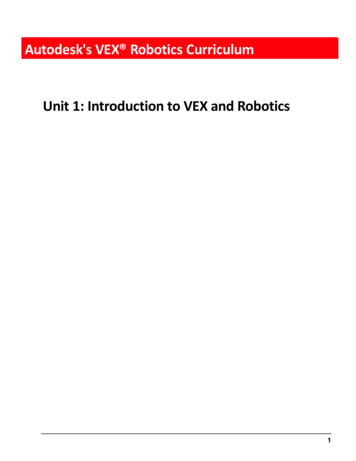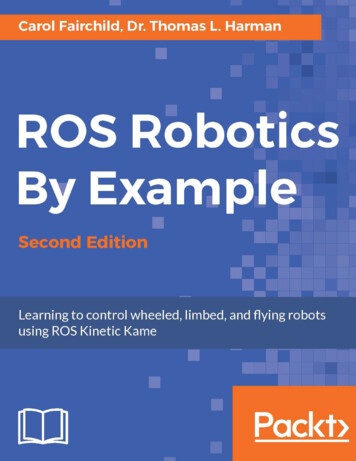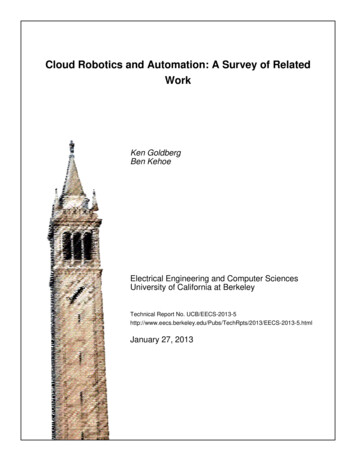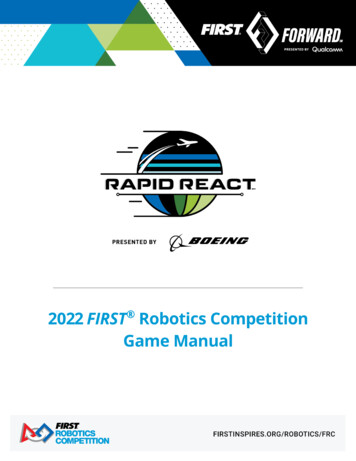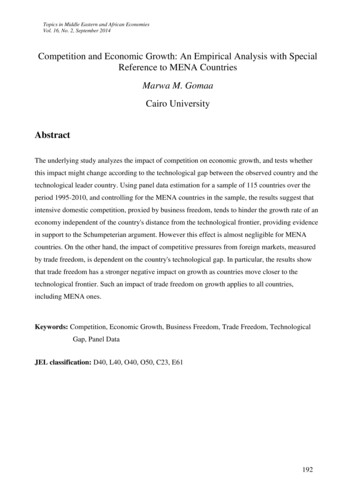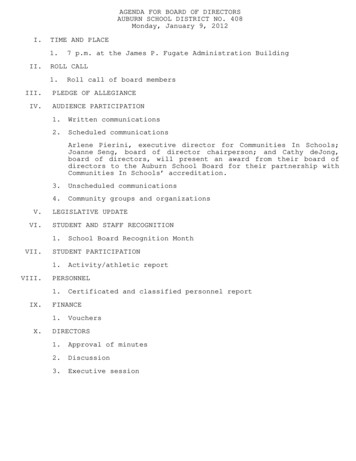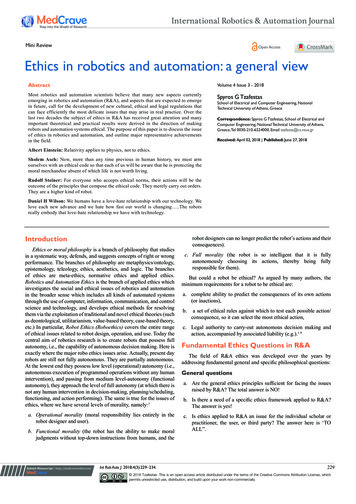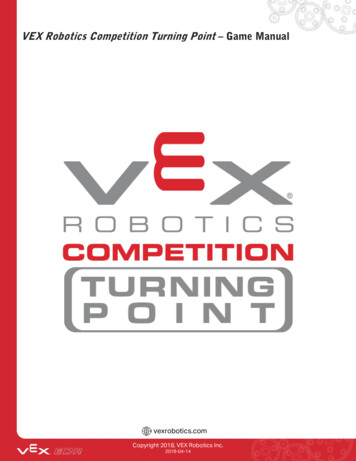
Transcription
VEX Robotics Competition Turning Point – Game Manualvexrobotics.comCopyright 2018, VEX Robotics Inc.2018-04-14
VEX Robotics Competition Turning Point – Game ManualTable of ContentsSection 1 – Introduction1Section 2 – The Game3Section 3 – The Tournament24Section 4 – The Robot31vexrobotics.comCopyright 2018, VEX Robotics Inc.2018-04-14
VEX Robotics Competition Turning Point – Game ManualSection 1 – IntroductionOverviewThis section provides an introduction to the VEX Robotics Competition and VRC Turning Point.The VEX Robotics CompetitionOur world faces a serious problem. It’s a problem that, without explicit and intentional action, willeventually stagnate global progress and lead to a workforce that is unmotivated and ill-equipped tosolve its future problems. As the world grows more technologically complex, the challenges weface every day will continue to escalate along with it. A cell phone has more failure modes than alandline. The internals of an electric car are more difficult to comprehend than a V8 combustionengine. Unmanned drone legislation is more nuanced than defining a maximum speed limit.Dubbed “the STEM problem”, the situation is equally simple to understand, yet difficult to solve. Inmany cases, the traditional methods of teaching science, technology, engineering, and math(STEM) will not be enough to adequately prepare students for this complex world. This is oftencoupled with the unfortunate reality that by the time they reach an age capable of grasping thesecritical topics, students may have already determined that they are “not cool” or “boring”. Withoutthe skills or passion necessary to approach these problems in an educated manner, you cannotpossibly expect to be productive in making forward progress or even sustaining the status quo.The VEX Robotics Competition exists to solve this problem. Through its uniquely engagingcombination of teamwork, problem solving, and scientific discovery, the study of competitiverobotics encompasses aspects of STEM. You’re not building VEX EDR robots because your futurejob will involve tightening shaft collars on a metal bar – you’re executing an engineering design andproblem-solving process that resembles the same mindset used by rocket scientists, brainsurgeons, and inventors around the world. VEX Robotics Competition Turning Point is not just agame that we invented because it is fun to play – it is a vehicle for teaching (and testing) teamwork,perseverance in the face of hardship, and provides a methodology to approach and solve newchallenges with confidence.Contained in this manual are the rules that shape VRC Turning Point. These rules are designed tosimulate the constraints that will outline any real-world project. They are intended to promotecreativity without punishing innovation. They are balanced to promote fair play while encouragingcompetition.vexrobotics.comCopyright 2018, VEX Robotics Inc.2018-04-161
VEX Robotics Competition Turning Point – Game ManualWe encourage you to keep in mind that a VEX Robotics Competition game is more than just a set ofgame objects worth varying amounts of points. It is an opportunity to hone the life-long skills thatwill characterize the problem-solving leaders of tomorrow.Good luck, and we’ll see you on the playing field!Sincerely,The VEX Robotics Game Design Committee, comprised of members from the Robotics Education &Competition Foundation, Robomatter, DWAB Technology, and VEX Robotics.VEX Robotics Competition Turning Point: A PrimerVEX Robotics Competition Turning Point is played on a 12 ft x 12 ft foam-mat, surrounded by asheet-metal and polycarbonate perimeter. There are eight Caps that can be Low Scored on theplaying field tiles or High Scored on six Posts around the field. There are also nine Flags, includingthree Low Flags which can be Toggled by Robots, and six High Flags, which can only be Toggled bybeing hit with Balls. Teams also score points for Alliance Parking at the end of the Match on theirown Alliance Platform, or by Center Parking on the Center Platform, which can be used by eitherAlliance.For more details and specific game-play rules, please see Section 2 – The Game.For more information about VEX, visit www.vexrobotics.com. Follow us on Instagram, Twitter orSnapchat @VEXRobotics. Like us on Facebook at www.facebook.com/vexrobotics.For more information about the Robotics Education & Competition Foundation, visitwww.roboticseducation.org. Follow us on Twitter @REC Foundation. Like us on Facebook atwww.facebook.com/RECFoundation.Visit www.RobotEvents.com for more information about the VEX Robotics Competition, includingteam registration, event listings, and results.vexrobotics.comCopyright 2018, VEX Robotics Inc.2018-04-162
VEX Robotics Competition Turning Point – Game ManualSection 2 – The GameOverviewThis section describes the 2018-2019 VEX Robotics Competition game entitled VEX RoboticsCompetition Turning Point. It also lists the game definitions and game rules.Game DescriptionMatches are played on a field set up as illustrated in the figures throughout. Two Alliances – one“red” and one “blue” – composed of two Teams each, compete in each Match. The object of thegame is to attain a higher score than the opposing Alliance by Scoring Caps, Scoring Flags, and byAlliance Parking or Center Parking Robots on the Platforms.A bonus is awarded to the Alliance that has the most points at the end of the Autonomous Period.Figure 1: Top view of the field in its initial setup configuration.Note: The illustrations in this section of the manual are intended to provide a general visual understanding of the game. Teams should refer toofficial field specifications, found in Appendix A, for exact field dimensions, a full field bill of materials, and exact details of field construction.vexrobotics.comCopyright 2018, VEX Robotics Inc.2018-04-183
VEX Robotics Competition Turning Point – Game ManualEach VEX Robotics Competition Turning Point Match includes the following: Eight (8) Capso Two (2) that start in a blue Low Scored positiono Two (2) that start in a red Low Scored positiono Four (4) that start on Balls in a non-Scored position Nine (9) Flagso Three (3) that start in a blue Toggled positiono Three (3) that start in a red Toggled positiono Three (3) that start in a non-Toggled position Twenty (20) Ballso Four (4) that start on the Platformso Eight (8) that start on Capso Four (4) that start underneath Capso Four (4) as Preloads, two (2) per Alliance Six (6) Posts, used for High Scoring Caps Three (3) Platforms, used for Alliance Parking and Center Parking Robotso Two (2) Alliance Platforms, one red and one blueo One (1) Center PlatformFigure 2: Front view of the field.vexrobotics.comCopyright 2018, VEX Robotics Inc.2018-04-184
VEX Robotics Competition Turning Point – Game ManualFigures 3 & 4: Annotated views of the fieldvexrobotics.comCopyright 2018, VEX Robotics Inc.2018-04-185
VEX Robotics Competition Turning Point – Game ManualFigures 5 & 6: Annotated views of the fieldvexrobotics.comCopyright 2018, VEX Robotics Inc.2018-04-186
VEX Robotics Competition Turning Point – Game ManualGame DefinitionsAlliance – A pre-assigned grouping of two Teams that are paired together during a given Match.Alliance Starting Tile – A colored field tile, red or blue, that designates where Robots must start theMatch.Alliance Station – The designated region where the Drive Team Members must remain for theduration of the Match.Autonomous Bonus - A point bonus awarded to the Alliance that has earned the most Cap, Flag,and Alliance Parking points at the end of the Autonomous Period.Autonomous Line – The pair of white tape lines that run across the center of the field, underneaththe Platforms. Per SG3 , Robots may not contact the foam field tiles on the opposite Alliance’sside of the Autonomous Line during the Autonomous Period.Autonomous Period – A fifteen second (0:15) time period during which Robots operate and reactonly to sensor inputs and to commands pre-programmed by the Students into the Robot controlsystem.Ball – A yellow plastic spherical object with a diameter of 3.0” (76mm) and a weight of 0.12lb (55g).Balls can be used to Score Flags.Cap – An 8-sided, disc-shaped plastic element with a “flat-to-flat” diameter of roughly 9.25”(234.95mm), an “edge-to-edge” diameter of roughly 9.70” (246.38mm), an overall height of roughly4.6” (116.8mm), and Caps weigh roughly 335g (0.74 lb). Caps have one blue side and one red side,and a Core in the center.Core – The cylindrical protrusion on either side of a Cap with a diameter of roughly 3.8” (96.5mm)and a height of roughly 1.8” (44.5mm) from the wide portion of the Cap. The Core has a red half anda blue half which are used when Low Scoring or High Scoring.Figure 7: Close-up of Cap, with the Core highlighted.vexrobotics.comCopyright 2018, VEX Robotics Inc.2018-04-187
VEX Robotics Competition Turning Point – Game ManualDetent – The protruding feature upon which the Flag pivots that is used in conjunction with theFlag’s pointer to determine if a Flag is Toggled.Figure 8: Close-up of Flag, highlighting the Detent and Flag pointer.Disablement – A penalty applied to a Team for a rule violation. A Team that is Disabled is notallowed to operate their Robot for the remainder of the Match, and the Drive Team Members will beasked to place their controller(s) on the ground.Disqualification – A penalty applied to a Team after a Match for a rule violation. A Team that isDisqualified in a Qualifying Match receives zero (0) Win Points, Autonomous Points, and Strength ofSchedule Points. When a Team is Disqualified in an Elimination Match, the entire Alliance isDisqualified and receives a loss for the Match. At the Head Referee’s discretion, repeated violationsand Disqualifications for a single Team may lead to its Disqualification for the entire tournament.Drive Team Member – Any of the three (3) Students allowed in the Alliance Station during a Matchfor each Team. Only Drive Team Members are allowed to touch the controls at any time during theMatch or interact with the Robot as per G5 . Adults are not allowed to be Drive Team Members.Driver Controlled Period – The one minute and forty-five second (1:45) time period during whichDrive Team Members operate their Robots.Entanglement – A Robot status. A Robot is Entangled if it has grabbed, hooked, or attached to anopposing Robot or a Field Element.Expansion Zone – The area of the foam tile playing surface bounded by the outer edges of thewhite tape lines and the inner edges of the field perimeter walls. Robots may expand vertically whilecontacting the foam field tiles or white tape lines within this zone. See rule SG2 for more detailson robot expansion.Field Element – The foam field tiles, field perimeter, white tape, Net, Platforms, Posts, Flags, and allsupporting structures.vexrobotics.comCopyright 2018, VEX Robotics Inc.2018-04-188
VEX Robotics Competition Turning Point – Game ManualFlag - A pivoting plastic element consisting of a red target, a blue target, and a hinge. Each targethas rectangular dimensions of 9.9” (251.5mm) wide and 6.00” (152.4mm) tall. Flags are elevatedabove the field. The hinge on each Flag also features a pointer that is used in conjunction with theDetent to determine if the Flag is Toggled. Low Flags are roughly 18.3” (464.8mm) from the field tiles to their top edge. Note: the top ofthe Low Flags can be used as a rough visual indicator to see if Robots are below 18”.High Flags are made up of two rows: one that is roughly 32.4” (822.9mm) from the field tilesto their top edge, and one that is roughly 46.3” (1176.0mm) from the field tiles to their topedge.Game Object – A Cap or Ball.Hoarding – A Robot status. A Robot is Hoarding if it is actively blocking opposing Robot access totwo (2) or more Game Objects that are in any of the four (4) corners of the field (i.e. positioned in thecorner roughly the size of one foam field tile.)Match – A Match consists of an Autonomous Period followed by a Driver Controlled Period for atotal time of two minutes (2:00).Match Affecting – A rule violation status determined by the head referee. A rule violation is MatchAffecting if it changes the winning and losing Alliances in the Match. Multiple rule violations within aMatch can cumulatively become Match Affecting.Net – The roughly 59” (1.5m) tall woven nylon net structure that spans the entire side of the fieldperimeter where the Flags are located, with a mesh width of roughly 2.0” (50.8mm) and an overallheight of roughly 58.6” (1488.4mm).Parked – One of two Robot statuses.Alliance Parked – A Robot status. A Robot is Alliance Parked when it is: Contacting its Alliance Platform.Not contacting the foam field tiles or white tape.Center Parked – A Robot status. A Robot is Center Parked when it is: Contacting the Center Platform.Not contacting any Alliance Platform.Not contacting the foam field tiles or white tape.vexrobotics.comCopyright 2018, VEX Robotics Inc.2018-04-189
VEX Robotics Competition Turning Point – Game Manual Figures 9 & 10: A Robot which is Alliance Parked (left) and Center Parked (right).Platform – One of three (3) raised surfaces made of PVC and polycarbonate, roughly 23.875”(606.4mm) by 21.70” (551.2mm), that can be used for Parking Robots. See Figures 5, 9, and 10. Alliance Platforms are denoted by their red or blue structural PVC pieces, and can only beused for Parking by Robots of the same color Alliance as the Platform.The Center Platform is denoted by its yellow structural PVC pieces, and can be used forParking by Robots of either Alliance.Note: The structures on the sides of the Center Platform are not considered part of thePlatform, and cannot be used for Center Parking. See Figure 11 and SG9 .Figure 11: A close-up view of the Center Platform, with the polycarbonate structure underneath highlighted. This structure’s intent is to keepBalls out from underneath the Center Platform per SG9 ; it cannot be used for Parking.Possession – A Game Object status. A Robot has Possession of a Game Object if it is carrying,holding, or encompassing it. See rule SG4 for details on Possession limits.Post – One of six (6) vertical PVC pipes attached to the field perimeter with a diameter ofapproximately 0.84” ( 21.5mm) where Caps can be Scored. Four (4) Posts (furthest from the Flags) are roughly 20” (508.0mm) tall.Two (2) Posts (closest to the Flags) are roughly 32” (812.8mm) tall.vexrobotics.comCopyright 2018, VEX Robotics Inc.2018-04-1810
VEX Robotics Competition Turning Point – Game ManualPreload – The Ball, one (1) per robot, that must be placed on the field such that it satisfies thefollowing conditions prior to the start of the Match. The Preload is touching one Robot.The Preload is fully within the field perimeter. XFigure 12: A legal Preload.Figure 13: An illegal Preload.Robot – Anything that has passed inspection that a Team places on the field prior to the start of aMatch.Scored – One of two Cap statuses.Low Scored – A Cap status. A Cap is Low Scored when a Cap’s Core is touching the foamfield tiles, white tape lines, or Platforms, without touching a Robot of the color Alliance forwhich the Cap would award points. Points for a Low Scored Cap are awarded to the Alliancecolor that is facing “up” when the Core half on its opposite side is touching the foam fieldtiles, white tape lines, or Platform.Note: If a Core is touching both the foam field tiles and the Center Platform, it should bescored as if it was only touching the foam field tiles. XFigure 14 (left): A Cap which is Low Scored for the Red Alliance, because the opposite Core is contacting the field tiles.Figure 15 (right): A Cap which is not Scored at all, because the Core is not contacting any field tiles, white tape lines, or Platforms.vexrobotics.comCopyright 2018, VEX Robotics Inc.2018-04-1811
VEX Robotics Competition Turning Point – Game ManualHigh Scored – A Cap status. A Cap is High Scored when its Core is touching a Post, the Capis not touching any other Field Elements, and the Cap is not touching a Robot of the colorAlliance for which the Cap would award points. Points for a High Scored Cap are awarded tothe Alliance color that is facing “up” when the Core half on its opposite side is touching thePost. XFigure 16 (left): A Cap which is High Scored for the Red Alliance, because the opposite Core is contacting the Post.Figure 17 (right): A Cap which is not Scored, because it is being contacted by a Robot of the same color as it would have been awarded points.Student – Anyone enrolled in a pre-college school or who is home-schooled as part of a precollege educational curriculum and is born after April 27th, 2000. Eligibility may also be grantedbased on a disability that has delayed education by at least one year. Middle School Student – A Student enrolled in grade 8 or lower or enrolled in grade 9 in aschool, which includes grade 8 but not grade 10. High School Student – Any eligible Student that is not a Middle School Student.Team – One or more Students make up a Team. A Team is classified as a Middle School Team if allmembers are Middle School Students. A Team is classified as a High School Team if any of itsmembers are High School Students. Teams may be associated with schools, community/youthorganizations, or a group of neighborhood Students.Toggled – A Flag status. A Flag is Toggled when the Flag’s pointer is not nested in the Detent andthe Flag is not touching a robot of the color Alliance for which the Flag would award points. WhenToggled, points are awarded to the red Alliance if the pointer is to the left of the Detent, andawarded to the blue Alliance if the pointer is to the right of the Detent. In the case that the Flagpivots beyond the containing PVC structure, the Flag is no longer Toggled. See Figures 18-20 onthe following page.vexrobotics.comCopyright 2018, VEX Robotics Inc.2018-04-1812
VEX Robotics Competition Turning Point – Game Manual X (Red)Figure 18 (left): A Flag tower depicting three Flag states. The top Flag is Toggled, and points would be awarded to the blue Alliance. Themiddle Flag is not Toggled. The bottom Flag is Toggled, and points would be awarded to the red Alliance.Figure 19 (right): Close-up of a Toggled flag, with the Detent and Flag pointer highlighted. This Flag is Toggled in favor of the red Alliance.Trapping – A Robot status. A Robot is Trapping if it has restricted an opposing Robot into a small,confined area of the field, approximately the size of one foam field tile or less, and has not providedan avenue for escape. Trapping can be direct (e.g. pinning an opponent to a field perimeter wall) orindirect (e.g. preventing a Robot from escaping from a corner of the field).vexrobotics.comCopyright 2018, VEX Robotics Inc.2018-04-1813
VEX Robotics Competition Turning Point – Game ManualGame RulesScoringAutonomous Period Scoring: A Toggled High Flag is worth two (2) points. A Toggled Low Flag is worth one (1) point. A High Scored Cap is worth two (2) points. A Low Scored Cap is worth one (1) point. A Robot which is Alliance Parked earns three (3) points. An Alliance that wins the Autonomous Bonus earns four (4) points.Driver Controlled Period Scoring: A Toggled High Flag is worth two (2) points. A Toggled Low Flag is worth one (1) point. A High Scored Cap is worth two (2) points. A Low Scored Cap is worth one (1) point. A Robot which is Alliance Parked earns three (3) points. A Robot which is Center Parked earns six (6) points.Figure 20: Example VRC Turning Point match, depicting various point values.vexrobotics.comCopyright 2018, VEX Robotics Inc.2018-04-1814
VEX Robotics Competition Turning Point – Game ManualSafety Rules S1 Be safe out there. If at any time the Robot operation or Team actions are deemed unsafe orhave damaged any Field Elements or Game Objects, the offending Team may be Disabled and/orDisqualified at the discretion of the Head Referee. The Robot will require re-inspection before itmay again take the field.a. Teams should be extra cautious when interacting with the Net, per SG5 . S2 Stay inside the field. If a Robot is completely out-of-bounds (outside the playing field), it willbe Disabled for the remainder of the Match.Note: The intent is NOT to penalize Robots for having mechanisms that inadvertently cross thefield perimeter during normal game play.General Game Rules G1 Treat everyone with respect. All Teams are expected to conduct themselves in a respectfuland professional manner while competing in VEX Robotics Competition events. If a Team or any ofits members (Students or any adults associated with the Team) are disrespectful or uncivil to eventstaff, volunteers, or fellow competitors, they may be Disqualified from a current or upcomingMatch. Team conduct pertaining to G1 may also impact a team’s eligibility for judged awards.Repeated or extreme violations of G1 could result in a Team being Disqualified from an entireevent, depending on the severity of the situation.Robotics competitions often induce intense, high stress situations. These are good opportunitiesto model and/or gain experience in handling these situations in a positive and productive manner.It is important that we all exhibit maturity and class when dealing with any difficult situations thatmay present themselves in both the VEX Robotics Competition and our lives in general.This rule exists alongside the REC Foundation Code of Conduct. Violation of the Code of Conductcan be considered a violation of G1 and can result in Disqualification from a current Match, anupcoming Match, an entire event, or (in extreme cases) an entire competition season. The Code ofConduct can be found at s/vex-roboticscompetition/ . G2 Use common sense. When reading and applying the various rules in this document, pleaseremember that common sense always applies in the VEX Robotics Competition.vexrobotics.comCopyright 2018, VEX Robotics Inc.2018-04-1815
VEX Robotics Competition Turning Point – Game Manual G3 Robots begin the Match in the starting cube. At the beginning of a Match, each Robot mustbe smaller than a volume of 18” (457.2 mm) long by 18” (457.2 mm) wide by 18” (457.2 mm) tall.Using Field Elements, such as the field perimeter wall, to maintain starting size is only acceptable ifthe Robot would still satisfy the constraints of R4 and pass inspection without the Field Element.Robots in violation of this limit will be removed from the field prior to the start of the Match, at theHead Referee’s discretion. G4 Keep your Robots together. Robots may not intentionally detach parts during the Match orleave mechanisms on the field.Minor violations of this rule that do not affect the Match will result in a warning. Match Affectingoffenses will result in a Disqualification. Teams that receive multiple warnings may also receive aDisqualification at the Head Referee's discretion. Multiple intentional infractions may result inDisqualification for the entire competition. G5 The red alliance, or the highest seed, places last. In Qualification Matches, the red Alliancehas the right to place its Robots on the field last. In Elimination Matches, the higher (better) seededAlliance has the right to place its Robots on the field last. Once a Team has placed its Robot on thefield, its position cannot be readjusted prior to the Match. If a Team violates this rule, the opposingAlliance will be given the opportunity to reposition their Robots promptly.a. Robots must be placed on the field promptly. Repeated failure to do so could result in aviolation of G1 . G6 Drive your own Robot. Each Team shall include up to three Drive Team Members. No DriveTeam Member may fulfill this role for more than one Team. G7 Only Drivers, and only in the Alliance Station. During a Match, all Drive Team Membersmust remain in their Alliance Station. Drive Team Members are not allowed to use any sort ofcommunication devices during their Match. Devices with communication features turned off (e.g. aphone in airplane mode) are allowed.Note: Per T02 , Drive Team Members are the only Team members that are allowed to be in theAlliance Station during a Match.Note 2: During a Match, Robots may be operated only by the Drive Team Members and/or bysoftware running on the Robot’s control system, in accordance with R11 and G9 .Violations or refusal to comply with this rule could be considered a violation of G1 .vexrobotics.comCopyright 2018, VEX Robotics Inc.2018-04-1816
VEX Robotics Competition Turning Point – Game Manual G8 Hands out of the field. Drive Team Members may only touch the Team’s controls and Robotat specified times during a Match as per G8a . Drive Team Members are prohibited from makingintentional contact with any Game Object, Field Element, or Robot during a Match, apart from thecontact specified in G8a .a. During the Driver Controlled Period, Drive Team Members may only touch their own Robot ifthe Robot has not moved at all during the Match. Touching the Robot in this case ispermitted for only the following reasons:1. Turning the Robot on or off.2. Plugging in a battery and/or power expander.3. Plugging in a VEXnet Key or V5 Robot Radio.4. Touching the V5 Robot Brain screen, such as to start a program.b. Drive Team Members are not permitted to break the plane of the field perimeter at any timeduring the Match, apart from the actions described in G5a .Minor violations of these rules that do not affect the Match will result in a warning. Match Affectingoffenses will result in a Disqualification. Teams that receive multiple warnings may also receive aDisqualification at the Head Referee's discretion. G9 Autonomous means “no humans”. During the Autonomous Period, Drive Team Membersare not permitted to interact with the Robot in any way, directly or indirectly. This could include, butis not limited to: Activating any controls on their VEXnet Joysticks or V5 Controllers. Unplugging or disconnecting from the field in any way. Triggering sensors (including the Vision Sensor) in any way, even without touching them.Violations of this rule would be considered a violation of G10 and could result in the AutonomousBonus being awarded to the opposing Alliance. Teams that receive multiple warnings may alsoreceive a Disqualification at the Head Referee's discretion. G10 Rules still apply in the Autonomous Period. Any infractions committed during theAutonomous Period that are not Match Affecting, but do affect the outcome of the AutonomousBonus, will result in the Autonomous Bonus being automatically awarded to the opposing Alliance.a. Teams are responsible for the actions of their Robots at all times, including during theAutonomous Period. Any infractions committed during the Autonomous Period that areMatch Affecting can result in a Disqualification, if warranted by the rule.b. If both Alliances cause infractions during the Autonomous Period that would have affectedthe outcome of the Autonomous Bonus, then no Autonomous Bonus will be awarded.vexrobotics.comCopyright 2018, VEX Robotics Inc.2018-04-1817
VEX Robotics Competition Turning Point – Game Manual G11 You can’t force an opponent into a penalty. Intentional strategies that cause an opponentto violate a rule are not permitted, and will not result in an infraction on the opposing Alliance.Minor violations of this rule that do not affect the Match will result in a warning. Match Affectingoffenses will result in a Disqualification. Teams that receive multiple warnings may also receive aDisqualification at the Head Referee's discretion. G12 Don’t destroy other Robots. But, be prepared to encounter defense. Strategies aimedsolely at the destruction, damage, tipping over, or Entanglement of opposing Robots are not part ofthe ethos of the VEX Robotics Competition and are not allowed. If the tipping, Entanglement, ordamage is ruled to be intentional or egregious, the offending Team may be Disqualified from thatMatch. Repeated offenses could result in Disqualification from the entirety of the competition.a. VEX Robotics Competition Turning Point is intended to be an offensive game. Teams thatpartake in solely defensive or destructive strategies will not have the protections implied by G12 (see G13 ). However, defensive play which does not involve destructive or illegalstrategies is still within the spirit of this rule.b. VEX Robotics Competition Turning Point is an interactive game. Some incidental tipping,Entanglement, and damage may occur as a part of normal gameplay without violation. It willbe up to the head referee’s discretion whether the interaction was incidental or intentional.c. A Team is responsible for the actions of its Robot at all times, including the AutonomousPeriod. This applies both to Teams that are driving recklessly or potentially causing damage,and to Teams that drive around with a small wheel base. A Team should design its Robotsuch that it is not easily tipped over or damaged by minor contact.Note 1: Teams who attempt to utilize the Center Platform should expect to encounter vigorousinteractions from opponent Robots who are attempting to do the same. Engaging in thisgameplay element of VRC Turning Point constitutes an acknowledgement of the risk ofincidental tipping or damage, as covered by G12b and G12c , and waives the protectionthat is offered by G12 against destructive interactions.Note 2: The Alliance Platform is not included in Note 1. Robots which are Alliance Parked arestill protected by G12 against destructive or defensive strategies. G13 Offensive Robots get the “benefit of the doubt”. In the case where referees are forced tomake a judgment call regarding a destructive interaction between a defensive and offensive Robot,or an interaction which results in a questionable rules violation, the referees will err on the side ofthe offensive Robot.
VEX Robotics Compet ition Turning Point is not just a game that we invented because it is fun to play - it is a vehicle for teaching (and testing) teamwork, perseverance in the face of hardship, and provides a methodology to approach and solve new challenges with confidence. Contained in this manual are the rules that shape VRC Turning Point .

